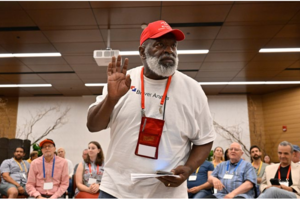To Give a Voice to the Political Center, Andrew Yang’s Forward Party Must Prove It Can Win

Editor's Note: The author of this article previously worked as a field organizer for Andrew Yang’s 2020 presidential campaign. Get all sides of this topic by reading another view: Why Andrew Yang’s Forward Party Might be our Best Option
A coalition of outsider groups led by former NYC mayoral candidate Andrew Yang promises to return American politics to the “sensible center.” They’re forming a new Forward Party, which aims to “stake out the space in between” the Democratic and Republican parties by pursuing “common ground.”
But does this “sensible center” actually exist? What does the “space in between” the two major parties really look like? Can the Forward Party stake out a clear definition of such an undefined and purportedly underrepresented coalition? And perhaps most importantly: can it win?
A “Center” media bias rating from AllSides doesn't necessarily mean a source is neutral, unbiased, perfectly reasonable or credible. It simply means a source does not predictably publish content tilted toward conservatives or liberals.
RELATED: Should You Only Read News Outlets AllSides Rates as Center?
For instance, Newsweek (Center bias) earns its rating not by being consistently neutral, but instead by publishing headlines and perspectives from both the left and the right. Meanwhile, news content from The Wall Street Journal (Center bias) is consistently neutral and nonpartisan in focus, and Blind Bias Surveys have consistently and overwhelmingly rated WSJ as “Center.”
A similar dynamic affects voters’ personal political affiliations. Someone could have moderate positions on every issue or a combination of extreme right and left positions that appear centrist in the aggregate.
RELATED: Rate Your Bias Quiz
Notably, being in the political “center” is not the same as identifying as an “Independent.” Identifying with neither the Democratic nor the Republican party could make you a moderate — or a communist, a religious nationalist, an anarchist, a neo-Nazi, etc. And, as previously stated, an Independent could support a mix of policies promoted by both parties.
The “center” also shifts over time. President Richard Nixon created the Environmental Protection Agency, and Southern Democrats were a major roadblock to passing civil rights legislation in the early 1900s. Thus, the Forward Party’s selection of “centrist” policy positions could largely depend on which “extremes” the Forward Party aims to thwart.
So far, the leaders of the new Forward Party have largely defined their political identities relative to the Republican and Democratic parties. They say they are “in between” — or, as Yang likes to put it, “not left, not right, forward.” But these are all ideas about what the new party isn’t, and where it’s departing from. What, if anything, is the new coalition for?
The new Forward Party says it will approach its platform “differently,” saying, “ We stand for doing, not dividing. That means rejecting the far Left and far Right and pursuing common ground.” It says it will use three “building blocks” to unite its “broad coalition”:
The new coalition also pledges not to “dictate a rigid, top down policy platform and expect it to work for all Americans.” This approach would be a stark departure from the current model of ideologically-based party platforms which, for all its negative externalities, provides a clear choice for voters.
Despite refusing to dictate policy positions, the Forward Party does appear to support some systemic changes, like ranked-choice voting and open primaries. Yang and other party leaders also say they support “the end of gerrymandering,” as well as “a push to make voting remarkably easy” and “incredibly secure,” although they offered no specific plans to implement those changes.
The party also backs a policy-making formula: Discover new ideas + Design sensible solutions + Deliver something = “Move Forward Together.” However, it is not clearly explained on the party website how this formula is different from the processes undergone by Democratic and Republican policymakers. After all, finding new ideas and crafting policy solutions isn’t new — there’s an entire think tank industry already doing this.
Some of the Forward Party’s goals appear contradictory, especially when getting into the weeds on specific issues.
For instance, it promises to reject “purity tests” by creating “a political home for everyone willing to set aside the partisan extremes.” This begs the question — what gets defined as a “partisan extreme”? And isn’t it also a “purity test” to demand members set aside a set of purportedly “extreme” ideas?
Furthermore, the Forward Party’s leaders say they want to implement policies that appeal to “most Americans” while representing the “space in between” the two major parties. But those two things are often at odds.
Recreational marijuana legalization, for instance, is supported by about 60% of Americans, with another 30% supporting legalization for medicinal use. From this perspective, the Forward Party should support legalizing weed — the median voter’s position.
Politicians, however, are split; Senate Democrats support legalization, while Senate Republicans overwhelmingly oppose it. If hypothetical Forwardist senators represent the “sensible center” between the parties, it is unclear what their exact position should be.
This speaks to a larger question concerning the centrist party’s positions — a lack of specificity. While politicians of all stripes make broad statements about “the direction of the country” and “working with the other side,” actual governance happens through specific policies and laws. Without specific positions, it would likely be difficult for voters to trust candidates with elected office.
CNN’s (Left bias) Jim Acosta asked Yang about this issue directly, telling him that he would “have to have policy positions at some point.” When Acosta — who appeared staunchly critical of the idea of a third party — asked Yang for his position on the end of Roe v. Wade, Yang pointed to a “common sense consensus majority” but offered no specifics.
Acosta pressed the issue again, saying the Forward Party sounded like a “fill-in-the-blank party,” adding, “in the real world, you have to take a position on something.” Yang responded by reasserting the Forward Party’s support for “the common sense consensus” on hot-button issues.
While Yang refused to fully answer Acosta’s question, Acosta may have been asking the wrong one. Perhaps the Forward Party, in rejecting the mere concept of a positions-based platform, doesn’t need to have stated policy positions at all. If it does, however, its actions so far do not imply a bright political future.
This presents a political problem for the centrist coalition: without clear policy positions, how do they convince voters to vote for their candidates instead of candidates from parties that offer specific stances?
When someone votes for a Democrat or a Republican, they’re likely voting for a set of policies championed by the candidate’s party. So when a voter goes to the polls in 2022 or 2024 and sees a Democrat, a Republican, and a Forwardist, they’re making a choice between Democratic policies, Republican policies, and a mystery mix of purportedly “centrist” policies. It could work — or the “sensible” centrist voters, unengaged, could stay home on Election Day.
At the end of the day, politics is not for tumultuous Thanksgiving dinner conversations or Instagram virtue signaling. Politics is for gaining and wielding power to accomplish one’s goals. The ultimate test of the political center’s viability is whether it can actually do that in today’s polarized political landscape.
That will require electing party members to public office, which will require convincing voters to not vote for Democrats or Republicans. It will require persuading voters not only that Forward Party candidates can win, but also that they can successfully serve in elected positions. It’s a tall order, and many have tried and failed.
If they can pull it off, it would mark a drastic and historic shift in American politics, akin to the rise of the Republican Party in the 1800’s, the post-1960’s ideological party switch, and the rise of modern polarization itself. That kind of change is rare — no matter how noble or foolish its advocates may be.
Do you think the Forward Party will be successful? Share your thoughts with us at admin@allsides.com.
Joseph Ratliff is a Daily News Editor at AllSides. He has a Lean Left bias.
This piece was reviewed by Henry A. Brechter, Managing Editor (Center bias), Julie Mastrine, Director of Marketing and Media Bias Ratings (Lean Right) and Clare Ashcraft, Bridging & Bias Assistant (Center bias).

April 19th, 2024

April 19th, 2024

April 18th, 2024

April 17th, 2024